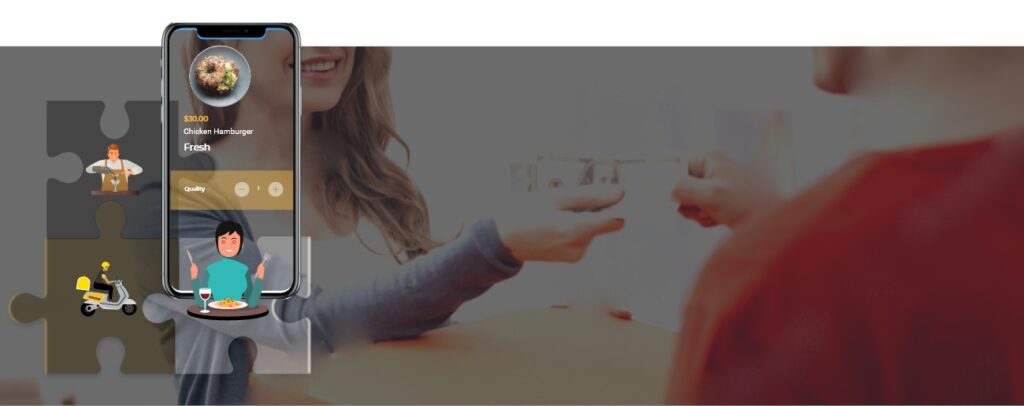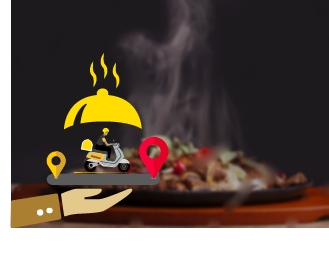
Zomato, UberEats, and GrubHub – the worldwide names synonymous with food delivery startup services are satiating people’s cravings almost round the clock. Are you game for it?
“Why can’t I make something like that?”
You can. Just the entrepreneurial spirit in you warms the thought. It’s for developing a food delivery service. What you need right now is action. The full-fledged action could be strappy for now. We’d give an account of knowledge, fascinating snippets, and valuable nuggets of information for you to invigorate the concept. Let’s begin.
Did you know?
Revenue in the Online Food Delivery segment amounts to US$122,739 million in 2020, as reported by Statista.
This data bank also reports a surge of users in Platform-to-Consumer delivery to 850.8 Million by 2024.
In 2020, the average revenue per user (ARPU) is $100.33 via Platform-to-Consumer delivery.
At least, you have got a fair idea that this isn’t a bleak business, right?
Entering the online food delivery sector is unequivocally challenging, but not impossible. Reprimanding yourself on the foot of the argument that you are not as good as brands like Zomato or UberEats is a junk idea. So, chuck it.
Your shining approach is beginning with local competition. As you delve deeper into research & statistics, you will discover a lot of negatives/disadvantages that your soon-going-to-be competitors are currently possessing.
On-the-grid Revenue Model for Startup Food-delivery Business

Imagine a jigsaw puzzle. Okay, not that big one, a small-basic would do. The startup you are focusing on has to do with something like this:
- Food makers
- Food deliverers
- Food eaters
How can you commonly relate all of them? – A mobile-based app(s). On-demand food delivery is some notches above the applications as you need partners like restaurateurs, delivery guys, and technical support team – the third-party service providers.
Monetizing the model for revenue is crucial for you, especially when you make a significant capital investment for the long-term. You can utilize these options for driving money home:
Fees for Delivery. Customers would happily pay if they don’t have to come out of their places voluntarily for every reason for food purchase. UberEats charges $4.99 with total delivery price, depending on the distance. Similarly, Swiggy charges 30-35% of the foods it delivers (only on orders below a certain price point).
Surge pricing. We don’t remain tight-lipped on that. When orders are placed during peak hours or rush hours, surge pricing occurs at different locations for on-demand food delivery. The rest of the sessions go smoothly as usual with the nominal delivery pricing.
Commission charges. A monthly price (varying between 7-18%) can be charged from partner restaurants, where clients aren’t charged anything. You can increase your revenues by partnering with not-so-popular restaurants or food joints.
Advertisements. Some popular apps like Zomato spend 55-63% of their budget on advertising to entertain new clients with delicious offers and promotions.
Style of Food Delivery Apps

DoorDash, Takeaway.com, Pizza Hut, Just Eat, McDelivery, and many more like them utilize more than one monetization approach for generating revenues, which encompasses surge pricing for on-demand food delivery, in-app advertising, and general commissions.
Does a single platform work for successful food delivery businesses? Well, not that we have heard of. As multiple personas (deliverers, restaurateurs, and customers) access the app, they must have customized accesses with their dashboard of controls.
The smart application must have a means for food ordering and delivery scheduling, secure payment integration, review or feedback section, GPS-based location tracking, and mobile-first UI/UX.
Features That Grasp A Customer’s POV
The customer wantonly spotlights:
- User-friendly App
- Exciting Price Deals
- Lightning-speed Delivery
- Safe Payment Methods
- Advanced features
The customer-only approach proves counter-productive. Instances of restaurants protesting food delivery app rules & regulations are coming from different corners of the world. We recommend a decentralized yet integrated formula for your business to become a success. Create four interfaces for customers, valets, restaurants, and admin/technical support.
- App for customer – Interface for the customer to pick delicacies, restaurants, combos, food deals, payment options, etc. It should also enable GPS tracking of valets/delivery guys.
- App for restaurant – Seamless interaction with food delivery business for receiving & processing orders, payment management, delivery tracking, in-app issue management.
- App for valet – Delivery valets access notifications of orders, order location, payment choices, GPS tracking of the customer, coordinating options (accept/divert orders), etc.
- App for admin – The admin control rounds on app interfaces for restaurants/customers, customer support system, technical emergencies, discount deals, bonanza offers, and so on.
Major Categories of Online Food Delivery Services
As you learn the monetizing concepts, you should understand these two categories of online food delivery services prevalent among the current crop of businesses:
Aggregators – Zomato, GrubHub, and Deliveroo are common meeting points for customers and restaurants, where customers directly place orders with them along with specials (examples – ‘Mouth-watering Chinese’, ‘Express Delivery’, ‘Budget-friendly Options’, etc.).
Restaurants that were unheard of can partner with aggregators without establishing a complicated system of corporate delivery service. Customers come to know about these restaurants from regular access to apps.
Logistic Support Platform – Restaurant-centric business models seek a platform with logistic support for keeping loyal customers, collect & process personal data, build & strengthen the corporate image.
The platform enables you to create products for the brand and recommend users with options from the menu. These restaurants are popular brands without the need for exclusive advertisement or promotion, as it occurs with traditional restaurant partners.
Key Performance Indicators (KPIs) for Startup Food Delivery Business
Key Performance Indicators or KPIs let you monitor the returns on investments, help you set your priorities, leverage on actionable insights, and improve overall performance.
Traffic Research
Who buys what? You should know that, shouldn’t you? A foodie binging on Chinese cuisines would admire how you present a plethora of delicacies to choose from. Bring them their favorite meals via superfast delivery and that too at an affordable price – customers will love it!
Captivating food deals on special hours or package meals at discounted rates are some of the proven strategies. We recommend you perform traffic research via studies, local area competition, available platforms, and statistics.
Promotional Campaign
Do users prefer one or two restaurants in a specific region? What is their buying behavior? How they rate restaurants? In collaboration with the restaurants, you can launch a promotional campaign. The key to finding success will be on facilitating the customer with a service that a competitor doesn’t. Play to their disadvantages and win the game.
User Retention
Remember, you have all parties to convince, entertain, and retain. Customer retention goes along for specialized/personalized offers, out-of-the-box menu ideas, instant customer support, superior online delivery tracking, and feedback platform.
Prepare a UI/UX that engages customers through interesting elements and restaurant-ranking system. Add ‘bestselling’ or ‘special recommendation’ for customers. New food delivery startup apps look intuitive and attractive.
Meanwhile, you can retain partners (restaurants or contractors) through bigger commissions on a flexible pricing order, bonuses, rating prizes, motivational targets, transport allowances, and so on. Happy partners will stay close to your startup business.
Set The Delivery Pricing for Better Outcomes
Don’t make it a barter exchange or you may suffer later. Contractors or valets lose interest in the food delivery business when they see their incentives decreasing gradually. Fallouts are possible too!
You should make competitive delivery prices for attracting diligent contractors. Reducing delivery costs or transportations costs is feasible via:
- Smart Synchronization Route for drivers to deliver in the same area or nearby destinations.
- Energy-efficient transportation modes that cost low on maintenance and travel.
- Reasonable Delivery Coverage from a commercial perspective. (For instance, areas covering up to 20 kilometers.)
Hot Food Delivery Trends

Statistics play a pivotal role in improved customer service quality. You can take note of the following where 28% of customers abandon a digital food order due to poor mobile or web app functioning. Similarly, 21% leave orders for not receiving customized options. Another 20% didn’t wait any longer because they couldn’t find answers about the menu items. Ensure this doesn’t miss your focal point.
Orders via social networking platforms (Twitter or Facebook), Smart Watches, Smart TVs, Virtual Assistants (Alexa), and various high-tech platforms are slowly taking over. Big Data, Drone Delivery and Augment Reality & Virtual Reality add over a special segment in the hot trends in the food delivery industry. Stay ahead of the curve to fulfill the expectations of demanding customers.
Go-To-Market Strategy for Developing an On-Demand Food Delivery App

Eliminating any unnecessary bloated explanations, we give you a simple, concise, and workable go-to-market strategy for developing an on-demand food delivery startup app for your business.
Scalability – Outline area coverage for not overwhelming yourself with capital inflows, manpower, resources, or insipid troubles. Create a platform to manage whatever you have in the present scenario.
Partnership – Establish healthy partnerships after an effective research. Develop a formula for earning commissions while paying rich dividends to the restaurant-partners.
Valets & Payment Strategy – The core of your business – valets should earn proper incentives via a reliable payment strategy, be it commissions per delivery or monthly/hourly deliveries.
Analytics – Energize your ideas of improvising the business with the host of analytics. GPS live-tracking, recorded travel logs, trip durations, customer food consumption patterns, and all raw data feeds help you improve customer satisfaction and profitability margins.
Cost of Developing A Food Delivery App for Business
In-house development could cost you more than 40% of outsourced development services. That’s a huge figure lying out there. On the other hand, you can put your trust in an app development company for creating a user-friendly, intriguing, and robust application.
The costs of an on-demand food delivery service app depend on crucial factors like digital product design & development, promotional campaigns, contractor training, partnership building, technical support for clients, features, support website, and so on.
Additional features like choice of platform (iOS or Android) incur varying costs. On a typical estimation formula, food delivery app development cost may fall between $15000 and $30000. You can rally behind the Best Food Delivery App Development Company for doing the honors.
Launching yourself in the industry of food delivery startup apps opens you to explore opportunities and realize untapped potential in the sector. Having a Smartphone-based food delivery service in any corner of the world lets you critically acquire and retain users. Match your interests and tap into the resources using an integrated strategy – profits will follow the suit.
Contact one of your experts here to start your food delivery business.









